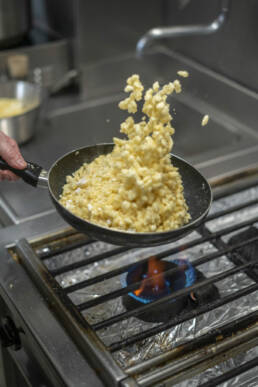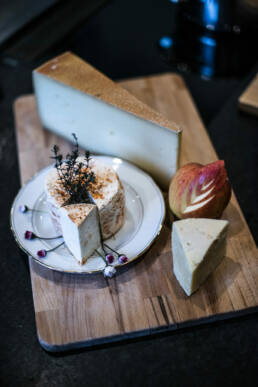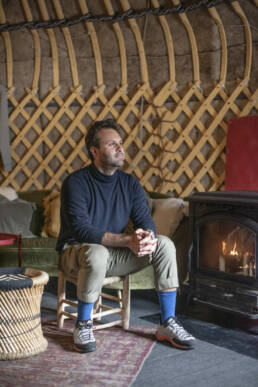From the avant-garde food scene in Lech to the homespun traditions of Montafon Valley, skiing in Austria delivers culinary contrasts that schmeckt gut.
A hush falls over the room. A dozen guests seated family-style around a large wooden table stare down at the appetizer placed before them: boiled lamb tongue, adorned with a conspicuous sprig of parsley.
Any culinary squeamishness was checked at the door long ago. It’s Chef’s Table night at Friends and Fools, the Rote Wand Gourmet Hotel’s curiously named special event kitchen and dining room. The chefs are putting on a show and it’s a gourmand’s dream come true.
The Rote Wand, near the Zugerbergbahn Talstation, has been in the Walch family since the 1950s when the parents of hotelier Joschi Walch renovated an old Zug farmhouse into a traditional Austrian mountain hotel, a short drive up-valley from Lech. When Joschi took over in 1986 he and wife Natasha reimagined the property. She leaned into her eye for design and gave it an aesthetically modern flair with touches of solid steel, custom light fixtures, minimalist furniture alongside curated art, photography, and sculptures. Joschi leaned into his love of food. Walch’s goal was to position Rote Wand as a destination for foodies keen on celebrating Austrian mountain cuisine featuring local cheese, wines, breads, seasonal fruits and vegetables—for the sort of guest who would appreciate a place that churns butter, bakes bread and ferments yogurt in-house. Joschi also wanted to offer menus amplified by an international appetite for experimentation. Friends and Fools is the latest expression of this expansive culinary vision.
“Our goal is to bring people from around the world, sit around a table together to eat and talk about food,” he says, explaining the simple concept behind Friends and Fools.
Outside, melting snow dripping from the gutters taps out a metronomic rhythm. Spring has arrived early to the Austrian Alps, presenting a perfect opportunity to let taste buds guide a journey.
Around here, vernacular and traditions can vary from one valley to the next. So does food. On this warm sunny week in March, we decide to explore a culinary yin and yang, from the bustle and buzz of Lech’s avant-garde food scene to the quiet, reliable traditions of the Montafon Valley. With less than 20 miles and a few mountain ridges separating them, these two valleys are worlds apart.
So far at Friends and Fools, it’s been an odyssey. It started with a Rote Wand spritz of red sweet vermouth, elderflower syrup, soda, and lemonade. Over the course of two hours and several glasses of Blaufränkisch, a red wine varietal from the Burgenland region of eastern Austria, we watched chef Tobias Schöpf bone and portion an entire lamb into cuts of rump, back, filet, rack and flank. Following that was a crash course on food fermentation, with a sampling of sumptuously fermented potatoes and pumpkin seed miso. The lamb tongue appetizer is course number five – five more to go.
Lech am Alberg’s food and après cred is as well established as its reputation for expansive ski terrain. In that sense the Rote Wand is right at home.
Tracks from the powder frenzy of the season’s biggest snowstorm 10 days ago are now frozen into north-facing off-piste lines of Lech Zürs. Warm weather followed quickly on the heel of the storm. Now wherever the solar is strong, it’s corn snow and spring skiing conditions and the masses are swooshing their way down to Zürs for lunch.
Lech’s culinary chops are both steeped in family recipes handed down through generations of farming and infused with the innovative spirit of chefs from the big city. Innovators like Vienna’s Paul Ivić whose TIAN am Berg pop-up restaurant at Hotel Edelweiss in Zürs brings a vegan twist to local food offerings. Similarly, Zayad Shah has lent his own cheeky twist to the area’s après culture.
Late in the day, we slide to a stop at the five-star Strolz ski rental shop, then stomp along a slushy sidewalk to the Kyrgyzstani yurt that sticks out in downtown Lech like a piercing on a tanned navel. I slip through the tent flap and find Shah stoking the woodstove in advance of the happy-hour crowd. We’re early.
“Village officials were a bit suspicious when I came to them with an unconventional concept,” Shah says with a laugh, as he mixes up a Negroni, one of his go-to cocktails. “But I thought it was time for some fresh bar concepts.”
Locals and visitors agreed. For the past five years Shah’s cozy yurt has been a must for locals and visitors looking to sip a cocktail next to a crackling woodstove before removing their ski boots for the day.
A woman in a fur collar peeks through the tent door, does a quick scan, then vanishes. Apparently, it’s not her thing. Experimentation and tradition sometimes strike a tenuous balance.
When it comes Austrian cuisine, it doesn’t get more traditional than spätzle. Skiing in Austria without noshing on a heaping plate of it would be like visiting Argentina and declining a filet mignon or juicy torpedo of beef—a form of culinary sacrilege. Spätzle, a handmade noodle, is Austrian soul food.
A half-hour ski tour from the Sonnenkopf top station and we’re posing for photos next to the giant cross tethered to the summit of Muttjöchle, along with a hale Austrian senior out for a solo walk on her skis. Muttjöchle is a popular pilgrimage for locals, an easily attained summit with panoramic views. And so is Panoramagasthof Kristberg, our lunchtime destination and a short traverse from the top of the Kristbergbahn Silbertal. The descent from Muttjöchle involves skirting a wild deer preserve in a subalpine forest that smells citrusy in the warmth of spring. Austrians love deer—both hunting and eating them. Sit in any traditional mountain restaurant and you’ll be surrounded by dozens of stag trophies, mounted on the walls and staring glassy-eyed as you carve self-consciously into a slice of venison.
Twenty minutes later and we’re at restaurant elevation. Snow has all but vanished so we clomp the last few hundred feet along a farm road flanked by steep green pastures. Pairs of skis are leaned randomly against the lift shack at the base of the local ski hill, as though people simply dropped their kit and walked away when the T-bar stopped turning for the season. A few patches of snow linger stubbornly on otherwise green pistes now being grazed happily by a few dairy cows. A silver-bearded dude straddles an e-mountain bike, puffing on a celebratory cigarette next to a sunny patio filled with families and friends enjoying a long Saturday afternoon repast.
In the kitchen chef Martin Schneider is busy whipping up mountains of spätzle. “This is the difference between high society and normal people,” Schneider says with a snicker, when I tell him where we lunched yesterday.
Traveling is always a study in contrasts and so it is in the Austrian Alps. The previous afternoon we sought refuge on the see-and-be-seen patio of Schlegelkopf next to a sun-worshipping supermodel delicately dining on Hakuba-inspired sushi and sippy bubbly.
A day later, we’re sharing a long wooden table with three robust farm girls gripping frothy pints of Austrian Märzen, looking like they could wrestle a steer to the ground. It’s irrefutable confirmation that we have indeed left behind the high society of Lech Zürs and entered down-to-earth, nothing-to-prove Montafon.
Chef Schneider’s delicious version of spätzle, Montafoner Käsespätzle, comes with roasted onions, salad and a special local touch, Sura Kees, or sour cheese. unique to the Montafon region. Locals are so proud of their sour cheese that the tourism board funded the cookbook Zu Tisch im Montafu, dedicated entirely to recipes showcasing Sura Kees. One of Schneider’s is included, pancakes with blueberries and sour cheese. Thomas Hildebrand also has a recipe in the book. This Montafon chef and culinary instructor recently opened a food event and guesthouse with his wife.
We meet the couple the following evening at the meticulously renovated farmhouse situated on a pastoral property a few minutes downstream from Gallenkirk. Evening shade draws across the valley, leaving only the very mountaintops gilded in amber. The thrum of a lowing cow hangs above the gentle rush of the Ill River.
“For a long time, Sura Kees was considered cheese for the poor people but now it’s getting popular. It seems Austrians are going back to their roots,” Hildebrand says, adding that there are more than a dozen dairy farms producing this Montafon specialty.
After another heaping plate of Hildebrand’s version of spätzle, we are face-to-face with a hefty portion of another classic, Kaiserschmarrn, the Emperor’s preferred dessert. These sweet fluffy pancakes are served with caramelized, rum-soaked raisins, and sprinkled with icing sugar to elevate the decadence to another rich and heavy level. It’s a meal unto itself. One wonders if such calorie-rich Austrian mountain dishes helped fuel the likes of Hermann Maier and this country’s many dominant ski racers over the years.
There’s no racing around at Gargellen ski resort the next morning. The clock has yet to strike noon, and already the sun is intense. Our guide Sandy Salmen, a smooth-turning and fast-talking ski instructor, is arcing lazily down the hill with his gloves tucked into the chest strap of his backpack. It’s the kind of weather that seems to propel a day on the slopes rapidly towards activities of the après variety.

First stop is a mid-morning coffee at Obwald Hütte, Gargellen’s original on-piste restaurant and bar. Here, we learn about the late Sepp Braunger, a legendary Gargellen pioneer who did it all, including heading up the ski school, mountain rescue, and avalanche control teams. Legend has it that he hiked up the mountainside with bags of concrete during the construction of this eatery years ago.
A few laps on the softening snow later, and we’re sliding to a stop next to Kessl Hütte, where Gargellen ski instructors go to unwind after long days teaching people how to go left and right.
Hubert Neher, bartender-proprietor, seems to have a cool-uncle relationship Salmen. The camaraderie is noticeable as soon as we walk through the thick, well-weathered wooden door. Before we find a stool at the bar, he’s already poured a round of schnapps, house-distilled from the root of gentian flowers that blossom during summer among the surrounding mountains.
“It’s like a big family here. We all help and know each other,” Salmen says, before four shots of this mountain spirit are downed and another round appears automatically.
In many ways, Montafon and Lech Zürs are like two disparate versions of the Austrian Alps, distant cousins who get awkward when forced to sit around the same table. Yet family matters in both.
Back at the Rote Wand Gourmet Hotel, Joschi Walch takes advantage of some rare quiet time to catch up on paperwork in his office cluttered with glossy books about food. This hotel started as a family hotel and remains so. Joschi and wife Natasha’s son and daughter both work on the food side of things, the next generation of Walches that will leave their mark on the culinary landscape of Lech Zürs. Joschi is a big man with an easy smile and a warm demeanor. When not putting in long days at the Rote Wand, he also travels with his tastebuds. “I met a group of 15 foodies at an event in Paris. Eight of them had been to the Rote Wand,” he says unable to suppress a little pride that the cuisine of a boutique family hotel in Zug has attracted a global following.
It’s another way of saying, mission accomplished.
Related Posts
December 11, 2019
Fast Forward-Lindsey Vonn Article & Photoshoot
What Lindsey Vonn has been up to since…




















